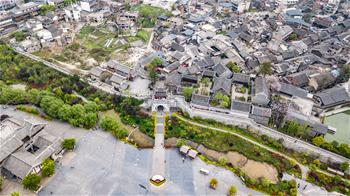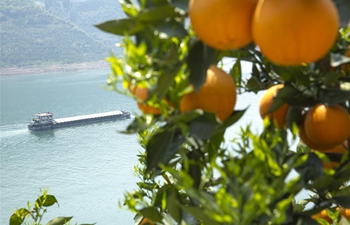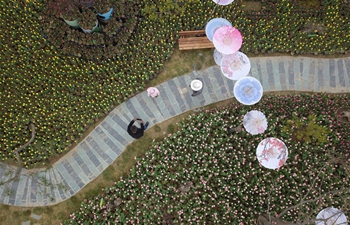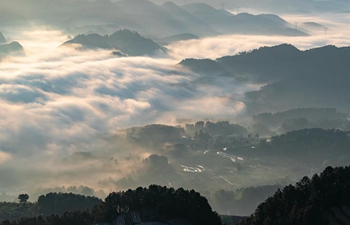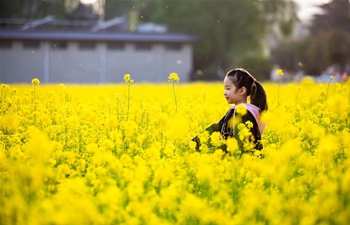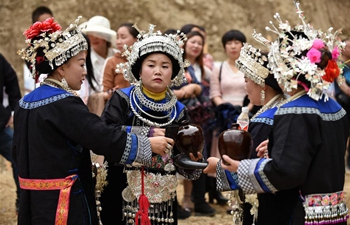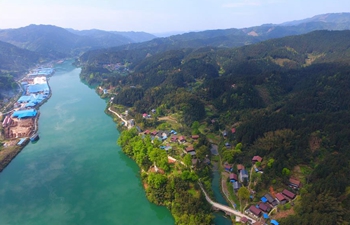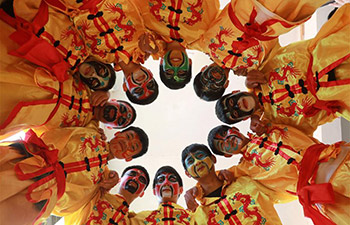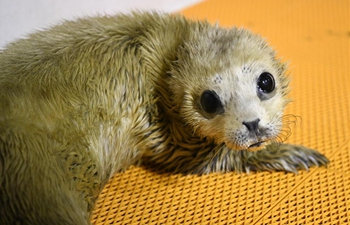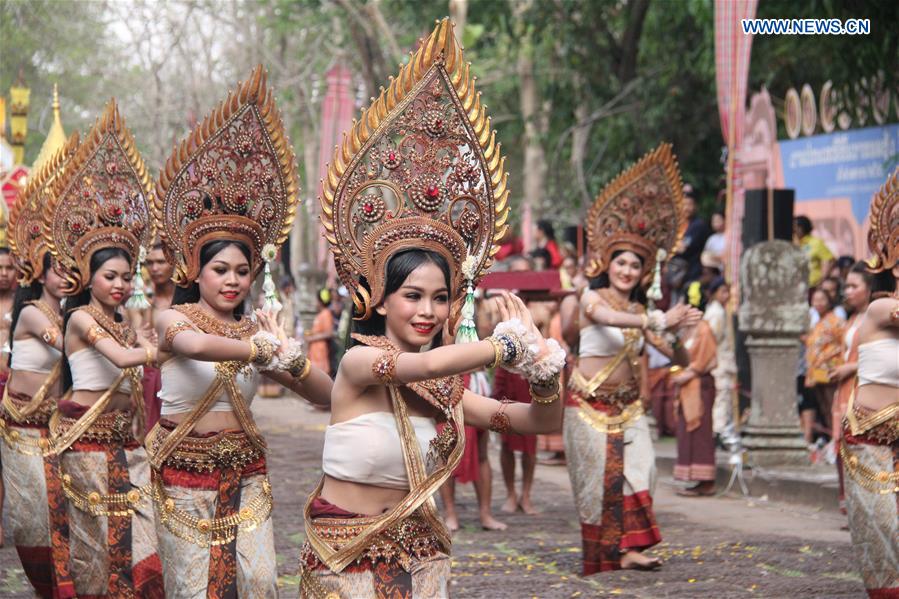
Performers dance on the parade Kheun Khao Phanom Rung, or "up into the Phanom Rung mountain", in Buriram province, northeastern Thailand, on April 6, 2019. The over three-hour parade is a ritual celebrated by locals for years in order to promote traditional culture and attract tourists. (Xinhua/Yang Zhou)
by Yang Zhou
CHALOEM PHRA KIAT, Thailand, April 7 (Xinhua) -- On the scorching Saturday afternoon, dozens of local Thai students dressing up like apsaras were dancing together on the stairway in front of the main sanctuary of Phanom Rung, an ancient Khmer temple in northeastern Thailand. This is a part of an annual event held on Friday and Saturday to promote traditional culture and attract tourists.
The female students, all in red with apsara crowns, danced with local music, in front of the seven-head naga sculptures and the ancient temple.
"I feel so proud to dance here as I am the child of Buriram province," said Kanchana Kanchana, a local female university student. "I hope foreign tourists could come to get to know Phanom Rung and Buriram as well as our culture."
The apsara dancing was the climax of an over three-hour parade Kheun Khao Phanom Rung, or "up into the Phanom Rung mountain", a ritual celebrated by locals for years.
Buriram, a northeastern province of Thailand bordering Cambodia, with its land under the rule of Khmer Empire a thousand years ago, is home to many ancient Khmer temples and other constructions as well as Khmer language speaking population.
Among these ancient Khmer structures, Phanom Rung temple is the most famous one.
Nestled at the top of an extinct volcano, the temple, believed to exist since the 10th century with several eruptions until the 13th century, was dedicated to Hindu deity Shiva, according to the Buriram government's official website.
The name Phanom Rung, a Khmer word referring to "great mountain," can be found in ancient inscriptions in the temple, which also mentioned names of several kings of the Khmer Empire.
The main tower of the temple was built during the reign of a local lord, Narendraditya, son of the princess of Angkor Bhupatindra Lakshmi Devi.
According to the Thai official history, Narendraditya was a smart and powerful leader who fought for Suryavarman II, one of Khmer Empire's greatest kings.
The Saturday's event set up a scene that Narendraditya's mother goes to the ancient temple on Phanom Rung to worship gods on a palanquin with parades.
Narendraditya's mother this year was played by Orn-anong Panyawong, who is the Miss Thailand 1992. Many Burriram students and local residents dressed in traditional attire participated in the parades with hundreds of local people watching it along the ancient pathway leading to the sanctuary.
Besides the Saturday's parade, there was also rounds of apsara dancing in front of the sanctuary. Light and sounds show displayed the history of the temple.
During the exhibition, it was told that, like the temple of Angkor, Phanom Rung was lost in the forest until it was discovered by the Frenchman Etienne Aymonier in 1885.
In 1971, the Thai government began to restore the temple and it was opened to the public as a historic park in 1988.
Some inscriptions were found inside the temple in Khmer and Sanskrit language and Thai Princess Maha Chakri Sirindhorn contributed to the interpretation by her thesis on the translation of the inscriptions in 1978.
The highlight of the ancient Khmer temple is not only the annual events but also a sunlight spectacle.
There are a few days every year that the rays of the rising sun would pass through 15 doorways of the ancient Khmer temple, creating a magnificent light in the center of the ancient sanctuary.
This year, though the local government announced that the perfects days to witness this spectacular scene were from Tuesday to Thursday but the clouds were too thick for the sunray to go through.
Although opening to the public for 31 years, the ancient site is currently only popular among local tourists, while the Tourism Authority of Thailand(TAT) believed it may attract more foreign tourists in the near future.
The TAT is one of the organizers of the two-day events and its deputy governor for domestic market Noppadon Pakprot told Xinhua that they contributed to the event, starting with inheriting local traditions and secondly promoting tourism.
According to the TAT, Buriram is one of 55 secondary tourism destinations in Thailand and the number of tourists and income have grown rapidly in recent years.
"I believe the new generation of tourists, especially Chinese tourists would look for new travel experience besides shopping," Noppadon said, adding that Buriram, with its historical sites such as Phanom Rung, abundant culture and original community may be a competitive tourist destination.
There are more ancient Khmer sites around Phanom Rung. Just 7.2 km from Phanom Rung lying a big baray, or ancient Khmer reservoir and a delicate temple Muang Tam, with its original name, lost in history.
Muang Tam, a name called by locals, means lowland town as it sits on the plain, a lower place compared with Phanom Rung on the extinct volcano.
The small temple, with four ponds surrounding the main sanctuary, dates back its primary phases of construction to 10th to 11th centuries.
According to local media, the Thai government is preparing to nominate Phanom Rung and its surrounding Khmer temples and structures, including Muang Tam, to be listed in UNESCO's world heritage.


